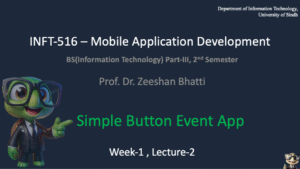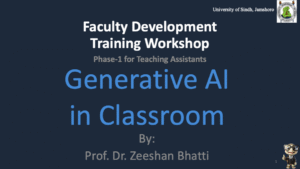Discover how Generative AI tools like ChatGPT and Gemini are revolutionizing classrooms! Explore practical ways teachers boost engagement, save time, and enhance learning, plus unique tips and FAQs for educators.

Generative AI is rapidly reshaping the landscape of modern education. If you’re wondering how tools like ChatGPT, Gemini, and DALLE can become your teaching assistants, you’re in the right place. In today’s lecture-inspired blog post, we’ll see exactly how Generative AI is transforming daily classroom tasks, helping teachers work smarter—not harder—while keeping education human-centered and interactive.

What is Generative AI?
To kick things off, generative AI doesn’t just analyze information—it produces new content! Think about ChatGPT drafting essays, DALLE creating artwork, or GitHub Copilot writing code. These tools rely on vast data patterns to generate the next word, image, or explanation, which makes them wonderfully flexible for a range of classroom needs. As a teacher, you don’t need to be a tech whiz to reap the benefits; simply being open-minded and a bit curious is enough.

Why Does Generative AI Matter for Education?
With generative AI, learning adapts to every student’s pace. Teachers are liberated from repetitive tasks, and creativity can flourish like never before. Importantly, AI isn’t about replacing teachers—that’s a myth. Instead, it’s about empowering educators to become superheroes who spend less time on administrative work and more time mentoring individual students.

Four Ways Teachers Can Use Generative AI
Let’s break down the real-world impact by exploring four fundamental uses of generative AI in the classroom.
- Lesson Planning & Lecture Creation:
AI tools help design lecture plans in just minutes. For example, teachers can ask ChatGPT to generate a 45-minute interactive lesson on photosynthesis, complete with objectives, examples, and even a quiz. With a few tweaks—like adjusting difficulty or including Blooms taxonomy terms—you get curriculum-ready material instantly. - Content Creation for Class Slides:
Imagine creating engaging slides with minimal effort! Paste a topic into ChatGPT, then use Canva Magic Write to design beautiful slides on the fly. This strategy saves up to 70% of your time in preparation, freeing you up for more creative work or extra coffee breaks. - Visuals and Diagrams On-Demand:
Abstract concepts become accessible when AI generates clear diagrams, whether for biology, physics, or computer science. However, it’s crucial to verify diagrams for accuracy before sharing them in class. - Student Engagement & Assessment:
AI-powered feedback tools help teachers evaluate student work for clarity, tone, and grammar, suggesting improvements instantly. Still, the teacher’s judgment remains central—AI supports but never replaces meaningful, personalized review.

Mastering Prompt Writing for AI Tools
One highlight from Prof. Bhatti’s talk is that learning how to write effective prompts is key to unlocking AI’s full teaching potential. Try prompts like:
“Act as a university lecturer. Create an engaging intro on AI ethics, include a real-world example and a discussion question.”
You’ll discover that changing the tone—from funny or academic, to motivational—can drastically alter the lesson style and keep students hooked.

🧠 Prompt: “Weekly Lecture Plan Generator”
Act as an expert university curriculum designer and academic planner.
You are tasked with creating a complete weekly lecture plan for the following course, based on the details provided below.
Input Information
• Course Title: [Enter Course Title here]
• Course Outline / Major Topics:
[Paste your course outline or list of topics here]
• Number of Weeks: [e.g., 16 Weeks]
• Classes per Week: [e.g., 3 Classes per week]
• Duration of Each Class: [e.g., 50 minutes]
• Preferred Week for Midterm: [e.g., Week 8]
• Final Week for Project/Review: [e.g., Week 16]
Your Task
1. Break down the provided course outline into a weekly lecture plan.
2. Ensure each topic is distributed logically across the total number of classes.
3. Include a Midterm Exam in the specified week and a Final Review or Project Week at the end.
4. Create a well-structured Excel-friendly table with the following columns:
o Week Number
o Class Number (1, 2, 3, etc.)
o Lecture Duration
o Topic / Sub-topic
o Lecture Objectives or Key Learning Outcomes
5. Ensure total content coverage, logical progression, and variety in teaching methods.
Opportunities & Advantages
Integrating generative AI into the classroom has massive benefits: teachers can focus on mentorship rather than busywork, and students benefit from personalized learning experiences tailored to their unique needs and interests. AI can generate quizzes, summarize lectures, or create revision games—sparking curiosity and engagement, every single day.

🧠 Prompt: “Lecture Slides Generator”
🧠 Prompt: “Lecture Slides Generator”
Act As a University Lecturer and Generate 20-slide PowerPoint content on the Title given below. Create a comprehensive slide with details , Code and examples. Use the reference book if possible to fetch some book material, cite where applicable.
Slide Topis : [Topic Goes Here]
Lecture Outcomes : [Lecture outcomes, sub topics goes here]
Reference Book: [Reference Book Goes Here]
-Give at least 2 real world example problems, with description and explain each concept. Source code solution
- the course will target first time learners.
- For each topic/heading must give 02 real world examples, defining problem to solve with detail, solution code, and output.
-Create the content with Following style
Slide Title: [Provide the slide title here]
Slide Content: [Provide the main content of the slide here. Keep it concise but
informative.]
Code Block: [With Some Example Code]
Output: [Output of the Example Code]
Slide Notes: [Provide detailed speaker notes or additional context for the slide
here . These notes are for the presenter.]
-Do Not use Emojis in Content. Answer in Chat. Write speaker script in simple text format.
Creating Visuals & Diagrams
Teachers can instantly visualize abstract concepts—AI-generated diagrams for computer networks, physics, biology, etc. Always verify for accuracy before using in lectures.

Enhancing Student Engagement
AI adapts explanations to age, background, and interest. You can ask the same concept explained “as a story,” “as a poem,” or “as a game.” Great for engaging different learning styles.

🧠 Prompt: “Enhancing Student Engagement”
Act as a professional teacher, and based on the course title below and For the topic below i want to students engagement by asking questions, suggest few questions that i can ask during slides for student interaction,
Course Title: [course title]
Topic: [topic goes here]
AI for Assessment & Feedback
Show how ChatGPT can act as a feedback assistant. However, emphasize that human judgment remains essential—AI can support grading but shouldn’t replace critical review.

🧠 Prompt: “Student Quiz”
For the topic below i want to create a MCQ based , include 10 MCQs, with answer. Keep the Quiz level [Moderate] with [Simple] language
Topic: [topic goes here]
Sub Topics: [additional Subtopic goes here]

🧠 Prompt: “Conceptual explanation/Summary in multiple styles”
Create a Short Summary for the next topic conceptually explaining the fundamental principals, working logic and real-world scenarios in MULTIPLE STYLES. Write as a lecturer explain the basics to the beginner learning programming for the first, Answer in simple English.
Topic: [topic goes here]
Sub Topics: [additional Subtopic goes here]
🧠 Prompt: “AI for Assessment”
Now For this topic I want to create an Evaluation Rubrics to assess students Work. Design 5 Short Questions for this topic, each having 5 marks. Create a clear evaluation rubrics to asses each questions breaking into 1 mark for each components
Topic: [topic goes here]
Sub Topics: [additional Subtopic goes here]
Challenges, Limitations, and Ethics
While AI is powerful, it’s not perfect. Teachers should always check facts produced by AI, cite sources, and emphasize ethical use. Plagiarism, copyright, and fairness concerns remain critical discussion points. Consequently, it’s essential to set classroom AI policies, explaining when and how to use these tools responsibly. Promoting AI literacy will help students navigate future tech-driven environments with confidence and integrity.

Ethical Use Guidelines
Encourage teachers to integrate AI policies in classrooms—explain to students when it’s okay to use AI and how to cite it responsibly. Promote AI literacy as a skill.

The Future of AI in Classrooms
Looking ahead, generative AI will personalize learning even more, support inclusive education, and integrate seamlessly into learning management platforms like Google Classroom and Moodle. Imagine adaptive lesson recommendations and smart quiz generators—these innovations are just the beginning.

Practical Demo Highlight
Try this step-by-step demo:
- Generate a lesson plan using ChatGPT.
- Instantly convert it into attractive slide content via Canva Magic Write.
- Create a quick 5-question quiz.
- Summarize the lecture in three key takeaways.
The time you save and the creative options you unlock will astonish you!
Recommended AI Tools for Teachers
- Lesson Planning: ChatGPT, Gemini, Perplexity, Eduaide.ai
- Slide Content Creation: Canva, Gamma, Tome, Beautiful.ai
- Quiz & Assessment: Quizizz AI, Gradescope, Formative
- Student Support: Socratic, Khanmigo, ChatGPT
- Research Summaries: Elicit.org, Scite.ai, Consensus.app
These platforms ensure that teachers, not technology, remain innovators and leaders in the classroom.

FAQs: Generative AI in the Classroom
Q: Will AI replace teachers in the future?
A: Absolutely not. AI exists to support, not replace, educators, allowing them to mentor more effectively.
Q: Can AI personalize my teaching methods?
A: Yes! Generative AI customizes content and feedback to each student’s learning style and pace.
Q: Are there risks to using AI for grading?
A: While AI offers efficient feedback, human oversight is essential to maintain accuracy and fairness.
Q: What ethical guidelines should teachers follow?
A: Verify all content, educate students about responsible use, and promote proper citation to prevent plagiarism and ensure ethical AI integration.
Q: Which AI tool is best for creating educational visuals?
A: Canva Magic Write and DALLE are favorites—just always double-check the accuracy of generated diagrams before use.

Final Thoughts
Ultimately, generative AI empowers teachers who are willing to experiment and adapt. By embracing these tools, educators reinvent their roles—not only as knowledge providers, but as creative mentors for the next generation. For practical tips, prompts, and slide materials, revisit www.codewithdrzeeshanbhatti.com.[1]


